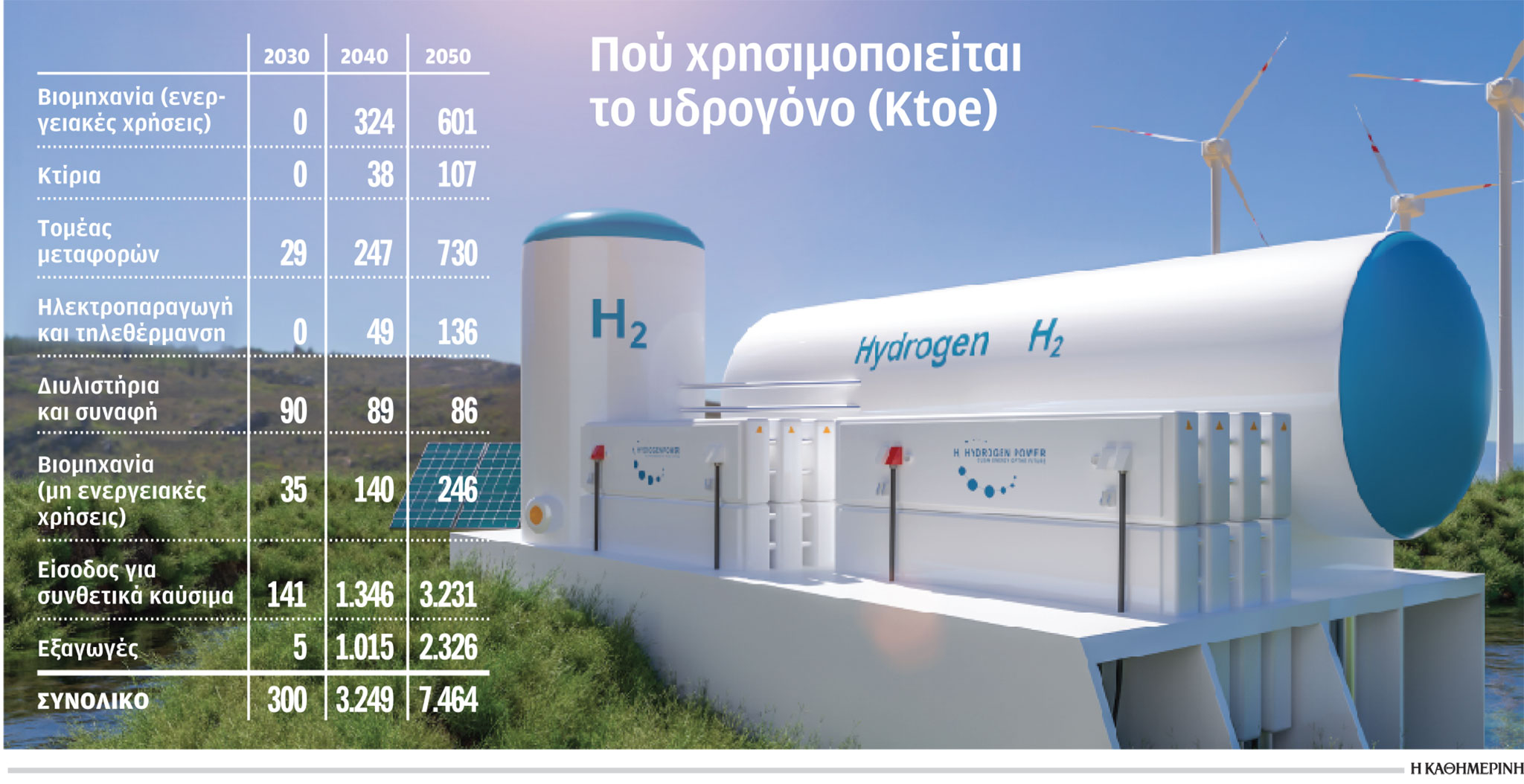
Greece is setting ambitious targets for the production of green hydrogen, a fuel that will complete the energy transition equation by replacing fossil fuels in sectors that are difficult to electrify, such as heavy industry and transport, as part of a national hydrogen strategy underlying the equally ambitious targets. supplied by the EU. as part of its strategy of climate neutrality (Fit-for-55) and independence from Russian fuel (REPowerEU).
Most recently, EU President Ursula von der Leyen announced the creation of a new European hydrogen bank, preceded through REPowerEU by raising the target for green hydrogen use in industry and transport from 11 metric tons (MT) per year by 2030 to 20 MT. , with use in all sectors of the economy. The Brussels plan provides for the replacement of 27 billion square meters. gas and 80,000 barrels of oil per day, which, according to the International Energy Organization (IEA), will reach $700-800 billion by 2030. Under these conditions, Greece is developing its own strategy for integrating hydrogen into its energy balance and claims to be a green hydrogen transporter through gas pipelines passing through its territory, as well as those that are at the planning stage.
EastMed has the potential to become “the backbone of EU supply” in the long term. with hydrogen,” according to an opinion recently expressed in the German newspaper Handelsblatt gg by Alexander Sduku.
The roadmap for incorporating hydrogen into the country’s energy mix has been finalized by a 20-member competent committee of the Ministry of the Interior, chaired by NTUA Professor Pantelis Capru, and is expected to be presented on Monday 7 November at a special meeting. an event in Zappion jointly organized by the European Hydrogen Association, the regions of Crete, Western Macedonia and Thessaly and the National Hydrogen Strategy Development Committee. The event will be attended by European Hydrogen Union Managing Director George Hatzimarkakis and Ministers of Development Adonis Georgiadis, Climate Crisis and Civil Protection Christos Stylianidis and Deputy Minister of Transport and Infrastructure Michalis Papadopoulos.
Greece, in accordance with the national hydrogen strategy, can produce about 3 Mtoe in 2040. green hydrogen (metric tons of oil equivalent) and export 1 million toe. worth 1.6 billion euros per year.
The northern road of Crete will be transformed into a “hydrogen road” with five filling stations.
The total turnover of the hydrogen supply chain in Greece will be around 10 billion euros per year in 2050. By then, about 60 GW of renewable energy will be needed to power the electrolysis plants (30 GW by 2040). The national strategy provides for accelerated procedures for licensing RES projects for hydrogen production, licensing and connection to the grid and state assistance until 2030 due to the immaturity of the technology, which makes the cost of investment very high. Moreover, the EU is moving in the same direction, having approved funding for a total of 41 projects, including two Greek ones from B&T Composites (H2CAT project) and Advent (Green HiPo project) in the amount of 800 million euros of public spending.
The White Dragon mega-project, which is a set of projects for the production of green hydrogen in Western Macedonia by electrolysis, which will be powered by photovoltaic cells and sent to the DESFA network and the TAP pipeline, has remained out of funding at this stage. . The project will be submitted at the next stage for inclusion in the list of Important Projects of Common European Interest (IPCEI) of the EU.
Primarily, hydrogen will replace gray hydrogen in refineries and fuel ships and aircraft. Both of the country’s refineries have already planned pilot programs to produce clean hydrogen. The first stage also includes the renewal of the city bus fleet by 120-250 hydrogen buses in the centers of large cities and intercity buses by 30-50, city delivery trucks (5000-10000), heavy-duty garbage trucks (80-160), IX (30,000-60,000 ), trains (3-12 trains for electric propulsion), passenger-ferry ships, etc.
In buildings, the plan provides for the complete exclusion of petroleum products from the fuel mixture for thermal purposes by 2035.
In the natural gas network, the percentage of hydrogen up to 10% can be transported with minimal conversion, and the percentage can be increased up to 20% after special agreements.
The national strategy also includes business initiatives in a number of areas, such as the construction of the first ocean-going ships by Greek shipowners, the launch of a hydrogen ship connecting Piraeus with nearby Saronic destinations, and the modernization of the axis of the North Road of Crete. (Northern axis of Crete) to the Hydrogen Road. The project concerns the construction of five 350 bar hydrogen filling stations in Chania, Rethymno, Heraklion, Ierapetra and Sitia to supply intercity buses (KTEL of Crete), as well as hydrogen trucks to connect with the new airport of Crete, the port of Heraklion and the industrial area of Heraklion. It also includes the design of a “hydrogen island” modeled on the Mallorca pilot project, as well as the experimental use of hydrogen as a fuel for Navy submarines.
Source: Kathimerini
Lori Barajas is an accomplished journalist, known for her insightful and thought-provoking writing on economy. She currently works as a writer at 247 news reel. With a passion for understanding the economy, Lori’s writing delves deep into the financial issues that matter most, providing readers with a unique perspective on current events.